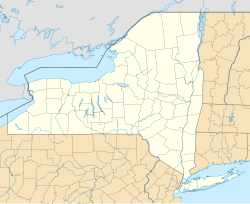Fort Saint-Frédéric was a French fort built on Lake Champlain to secure the region against British colonization and control the lake. It was located in modern New York State across the lake from modern Vermont at the town of Crown Point, New York. The fort, whose construction began in 1734, was never attacked, and was destroyed in 1759 before the advance of a large (more than 10,000 man) British army under General Jeffery Amherst.
Fort Saint-Frédéric | |
 Model of Fort Saint-Frédéric | |
| Location | Crown Point, New York |
|---|---|
| Coordinates | 44°1′45″N 73°25′52″W / 44.02917°N 73.43111°W |
| Built | 1734 |
| NRHP reference No. | 66000517 |
| Significant dates | |
| Added to NRHP | October 15, 1966[1] |
| Designated NHL | October 9, 1960[2] |
The British constructed the much larger Fort Crown Point next to the ruins of Saint-Frédéric; the new fort also never came under attack. Its small garrison was captured in 1775 in the early days of the American Revolutionary War, after which Fort Crown Point also fell into ruin. The fort sites at Crown Point were preserved in the Crown Point State Historic Site in 1910, and both ruins are National Historic Landmarks.
History
editConstruction was started in 1734 by Gaspard-Joseph Chaussegros de Léry. When complete, Fort Saint-Frédéric walls were twelve feet thick and four stories high, with cannons on each level. It was manned by hundreds of officers and troops, principally from Les Compagnies Franches de la Marine.[3]
The fort gave the French control of the frontier between New France and the British colonies to the south. As the only permanent stronghold in the area until the building of Fort Carillon at Ticonderoga starting in 1755, many French raids originated there and it was a target of British operations in the French and Indian War. Constructed on the tip of a strategic peninsula at a narrows in the lake, the cannons of Fort Saint-Frédéric and the later British Fort Crown Point were capable of halting all north-south travel on the lake.
In 1759 when British forces moved against Fort Saint-Frédéric during the war, the retreating French destroyed it.[4] The British Army and provincial militia then built Fort Crown Point, a vast fortification just southwest of the ruins of the French fort, starting in the fall of 1759. At the same time they built a fleet to gain military control of Lake Champlain and the 77-mile-long Crown Point Road across the Green Mountains to reach the Connecticut River.
Since 1910 the remains of both forts on the Crown Point peninsula are part of the Crown Point State Historic Site. Both are also U.S. National Historic Landmarks. Fort Saint-Frédéric was registered as a National Historic Landmark in 1962.[2][5][6]
See also
editReferences
edit- ^ "National Register Information System". National Register of Historic Places. National Park Service. January 23, 2007.
- ^ a b "Fort St. Frederic". National Historic Landmark summary listing. National Park Service. 2007-09-12. Archived from the original on 2011-06-05.
- ^ Folwell, Elizabeth, and Amy Godine, Adirondack Odysseys, The Adirondack Museum, Blue Mountain Lake, New York, 1997; ISBN 0-936399-78-3, pg. 18
- ^ Folwell, Elizabeth, and Amy Godine, Adirondack Odysseys, The Adirondack Museum, Blue Mountain Lake, New York, 1997; ISBN 0-936399-78-3, pg. 19
- ^ Richard Greenwood (1976-02-20). "Fort St. Frederic". National Register of Historic Places Inventory-Nomination. National Park Service.
- ^ "Fort St. Frédéric--Accompanying photos from 1958 and 1967". National Register of Historic Places Inventory. National Park Service. 1976-02-20.
External links
edit- Crown Point State Historic Site (Official State park web site), at NYS OPRHP

